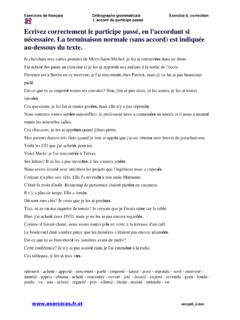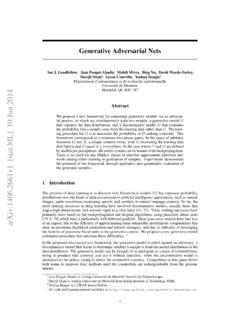Transcription of SVAR models and the short-run resilience efiect - …
1 SVAR models and the short -run resilience effectAlain GUAYU niversit e du Qu ebec `a montr ealCIRP EE and CIREQE-mail: PELGRINU niversity of Lausanne-HEC, DEEP and IEMSEUREQua, University of Paris IE-mail: do not quote without permissionThe views in this paper are those of the authors and not necessarily those of and the Introduction32 An overview of previous results43 Specification issues .. Identification scheme .. Data .. Lag selection .. Boostrapping method .. Tests .. 134 Benchmark estimation .. A comparative study of impulse-response functions .. 175 Robustness Conservative tests .. Alternative trend specifications .. The number of variables .. Alternative specifications .. Other OECD countries .. 206 Conclusion217 References2221 IntroductionIn an earlier study, the OECD examined whether some countries differ significantly intheir responses to shocks and assessed if economies with structural policy settings thatgenerates higher GDP growth and lower unemployment in the long run are also moreresilient, they are in a better position to absorb shocks and to recover more quicklyfrom adverse do so, part of the analysis was conducted by using structural VAR models (hence-forth, SVAR) based on short -run restrictions as well as a block exogeneity assumption,similar to those developed by Cushman and Zha (1997), and Dungey and Pagan (2000).
2 The short -run restrictions impose some contemporaneous feedback effects among thevariables following the methodology described in the seminal papers of Bernanke (1986),Blanchard and Watson (1986) and Sims (1986). The block exogeneity assumption restson the small open economy specification and means that the block of domestic vari-ables has no impact neither contemporaneously nor with lags on the block of foreignvariables in the VAR specification. In order to estimate each model and study the func-tions of interest (impulse-response functions, etc), all variables were detrended usingthe familiar HP results show that there appear to have been major differences in the capacityof countries to deal with the shock driven by the bursting of the ICT and stock marketbubbles. Two groups of countries emerge in terms of responses to this negative the one hand, the impact was largely contained in Australia, Canada, New Zealand,the United Kingdom, some Nordic countries and Spain.
3 In particular, the United Statesexperienced a quite rapidly rebound (following a large downswing). On the other hand,in large continental European countries, the shock has led to a protracted period ofweakness. One explanation rests on the behavior of private consumption and residentialinvestment. More specifically, the strength of these two demand components in the moreresilient countries seems to contrast sharply with the weakness in other , some concerns have been raised regarding the methodology, especiallythe opportunity to use an HP filter uniformly across countries and variables ( thesame smoothness parameter) and its implications for the inference and estimation ofSVAR models . Especially, in a companion paper, we show that pre-filtering data mayinduce some important distortions in the analysis (Guay and Pelgrin, 2006). In thisrespect, this paper re-examines the short -term economic resilience effect without HP-3pre-filtering the data and by providing two new formal tests to disentangle the differencesbetween the impulse-response of two rest of the paper is organized as follows.
4 In Section 2, we briefly describe the re-sults of our companion paper, In section 3, we present the structural VAR methodologyand we discuss the issues of VAR specification (selection of variables, lag determination,level versus first-differenced variables, trends, etc). Finally, we present the bootstrap-ping correction `ala Kilian (1998). In Section 4, we present the impulse-responses func-tions as well as their bootstrapped confidence bands. In section 5, we propose two newtests to compare the country-specific impulse responses functions. In section 6, somerobustness analysis is proposed. The last section An overview of previous resultsIn a companion paper, we provide evidence on the following conclusions when oneestimates a SVAR model using HP-filtered data. First, the value of the smoothnessparameter (of the HP filter) is not critical in the sense that it affects marginally, at leastfor the set of variables considered in the OECD study, marginally the statistical prop-erties of the filtered series.
5 However, using the methodology proposed by Marcet andRavn (2004), we showed that there is no prior reason to set the smoothness parameterhomogenously across countries and variables. Second, as in Guay and St-Amant (2005),we argued that the HP filter may lead to important distortions and a spurious cyclicalcomponent, especially with near-integrated series, which have the typical Granger s (asin most macroeconomic time series). Third, as in Canova (1998), we evaluated thequantitative effects of alternative detrending techniques and concluded that the charac-teristics of the extracted cyclical components vary widely across methods. This directlypointed the question of the reliability of the results and the need topriordetrend thedata in a SVAR model. In particular, the degree of persistence of each process as wellas the presence of (near-) unit roots in the MA representation of the cyclical componentcan lead to substantial distortions in the SVAR estimation, especially given the incon-sistency of estimates of the parameters.
6 Note, however, that these effects are difficultto quantify with accuracy. Fourth, using a Monte-Carlo investigation based on a struc-tural VAR model with short -run restrictions, we showed that the results obtained afterHP filtering the data lead to conclude that (i) the amplitude of responses to structuralshocks are clearly underestimated when the variables are persistent, (ii) the length ofthe adjustment period to a structural shock is also underestimated in this case and (iii)SVAR in level outperforms SVAR with HP filtered data. Fifth, using a Monte-Carlo4investigation based on a RBC model, we found the same conclusions. Finally, a sim-plified version of the OECD model was used to show thatt the results are particularlysensitive to the choice of the detrending addition, one critical issue is the definition of the short -term economic resilienceeffect. Indeed, in the OECD paper, the speed of adjustment after a structural shock ismeasured by the number of periods before the impulse-response functions cross the zeroline and not by the number of periods necessary to completely dissipate the effect of sucha shock.
7 This choice is not innocuous and yet may not have theoretical importantly, other definitions may lead to opposite conclusions. For example, ifthe speed of adjustment, as a measure of resilience , is captured instead by the durationuntil the effect of the structural shock totally disappears, then conclusions are less clearcut. For example, the simple average of the speed of adjustment for the responses tothe structural shocks on output increases to 15 periods for the United States comparedto periods for France (see Table 2, first and fourth rows). The implication is thatFrance now appears as more resilient than the United States, reversing the earlier directly raises the issue of how to properly define the resilience fundamentally, we can question the interpretation of the impulse-response func-tions from the point of view of a dynamic structural economic model. This is particularlyimportant since the concept of resilience is defined in the OECD paper as the ability toavoid long periods away from equilibrium following a negative shock.
8 This interpreta-tion is rather problematic if one considers RBC models or dynamic general equilibriummodels with nominal (or real) rigidities. At least, in a prototypical Real Business Cycleeconomy, the response to a shock is Pareto-optimal. In other words, at any time, theeconomy is at the equilibrium. Business cycles thus reflect the optimal responses ofeconomic agents to the economic environment. As a consequence, the impulse-responsefunctions simulated from this economy then represent the dynamic adjustment to the1 For example, let us examine the first impulse-response function reported in figure 8 (see OECDWP1 document). This corresponds to the impulse response of a world GDP shock to the adjustment time reported in Table 2 (see OECD WP1 document) for this impulse response is sevenquarters. In fact, the impulse response crosses effectively zero after seven quarters but the effect ofthe initial shock only disappears after fourteen quarters.
9 The difference is important and can changedrastically the conclusion drawing from the speed of adjustment reported in Table 2 (see OECD WP1document)2 The same comment applies if we look at the cumulative output gap reported in Table 3 (see OECDWP1 document).5steady state but not the periods away from the equilibrium (since impulse responsesare the Pareto-optimal responses from the point of view of the representative agent). Itis thus important to disentangle the concept of equilibrium and the steady state of aneconomy. The steady state corresponds to the deterministic state of the economy, there is no shock. The shape of the impulse-response functions is defined by thenumber of periods away from the steady state and, along these impulse responses, theeconomy could be or not at the equilibrium depending on the structure of the interpretation of impulse-response functions as the adjustment process to the equi-librium needs then to be done with serious the same spirit, we argue in appendix 3 of Guay and pelgrin (2006) that the definitionof the resilience effect, which rests on impulse-response functions, may be problematicin the OECD overcome both types of criticisms, we estimate structural VARs model withouta priorHP-filtering the data and we propose a univariate test to compare impulse-response functions at different horizons.
10 The interpretation of the comparison of impulse-response functions as a measure of resilience among countries can be rationalized ifwe suppose that the exogenous dynamic process of the structural shocks disturbingeconomies is the same for each economy. Under this assumption, the difference inimpulse-response function reflects a difference in the propagation mechanisms in the re-spective economy and can thus be interpreted as a difference in the degree of resilienceto structural MethodologyThe first question is how to proceed in order to correctly identify the dynamic adjust-ment after a structural shock given the specification of the variables of interest in theVAR model. As is explained in Guay and Pelgrin (2006), a first attempt might be toproceed with the SVAR in level. Even in the case where the variables are non stationary,one may estimate a SVAR in level. The estimated coefficients of the VAR with possiblynon stationary variables are consistent and the asymptotic distribution of individualestimated parameters is standard, a normal distribution (see Sims, Stock and Wat-son 1990)).
















